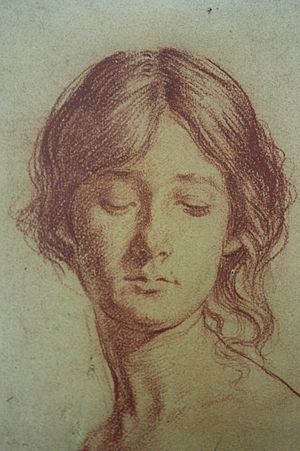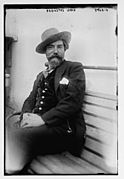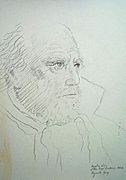Augustus John facts for kids
Quick facts for kids
Augustus John
|
|
|---|---|
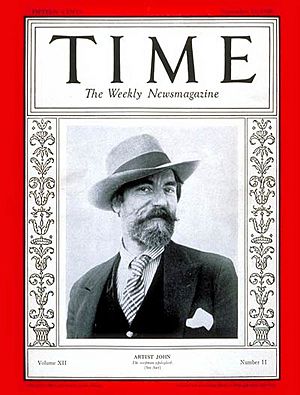
"Artist John," on a 1928 Time magazine cover
|
|
| Born |
Augustus Edwin John
4 January 1878 Tenby, Pembrokeshire, Wales
|
| Died | 31 October 1961 (aged 83) Fordingbridge, Hampshire, England
|
| Known for | painter |
| Movement | Post-Impressionism |
| Spouse(s) |
Ida Nettleship
(m. 1901; died 1907) |
| Partner(s) | Dorothy "Dorelia" McNeill |
| Awards | Order of Merit Royal Academician |
Augustus Edwin John (born January 4, 1878 – died October 31, 1961) was a famous Welsh painter, draughtsman, and etcher. An etcher is someone who makes prints using a special technique. For a while, many people thought he was the most important artist in Britain. The writer Virginia Woolf even said that by 1908, the time of other famous artists was ending, and the "age of Augustus John was dawning." He was the younger brother of another talented painter, Gwen John.
Contents
Growing Up and Learning Art
Augustus John was born in Tenby, Pembrokeshire, Wales. He was the third of four children. His father, Edwin William John, was a lawyer. His mother, Augusta Smith, passed away when Augustus was only six years old. However, she had already taught both Augustus and his older sister Gwen to love drawing.
When he was seventeen, Augustus briefly went to the Tenby School of Art. Then, he moved to London to study at the Slade School of Art, which is part of University College London. He quickly became the best student of the drawing teacher Henry Tonks. Even before he finished his studies, people thought he was the most skilled draughtsman (someone who draws well) of his time. His sister, Gwen, also studied at the Slade School and became a very important artist herself.
In 1897, Augustus had a serious head injury while diving into the sea. After a long time recovering, he felt more adventurous and his art grew even faster. In 1898, he won a special award called the Slade Prize for his painting Moses and the Brazen Serpent. After that, John studied on his own in Paris, where he was inspired by the artist Pierre Puvis de Chavannes.
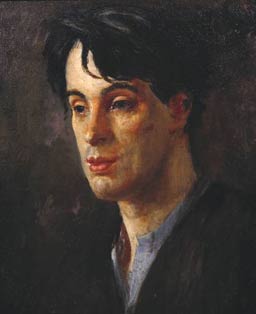
To support his wife, Ida Nettleship (whom he married in 1901), he took a job teaching art at the University of Liverpool.
Painting in North Wales
Around 1910, Augustus John and his friend James Dickson Innes spent two years painting in the Arenig valley in Wales. They especially loved painting the mountain Arenig Fawr. In 2011, this time was featured in a BBC documentary called The Mountain That Had to Be Painted.
Adventures in Provence
In February 1910, John visited a town called Martigues in Provence, France, and immediately fell in love with it. He wrote that Provence "had been for years the goal of my dreams" and Martigues was the town he liked the most. He felt like he had finally found a place to settle down. He continued to visit Provence until 1928, when he felt the town had lost its simple charm.
Throughout his life, John was very interested in the Romani people (sometimes called "Gypsies"). He often looked for them during his travels in the United Kingdom and Europe, and he even learned to speak some of their languages. For a short time after he got married, he and his family traveled in a caravan, just like the Romani people. Later, he became the President of the Gypsy Lore Society, a group that studies Romani culture. He held this position from 1937 until he passed away.
A War Artist
In December 1917, Augustus John became a war artist for the Canadian forces. He painted many memorable pictures of Canadian soldiers. He was supposed to create a huge painting for Lord Beaverbrook, and his sketches showed it could have been his greatest large artwork. However, like many of his big ideas, it was never finished. As a war artist, John was allowed to keep his beard, which was unusual for officers at the time. After two months in France, he was sent home after getting into some trouble. Lord Beaverbrook helped him avoid serious punishment and sent him back to France. There, he made studies for a Canadian War Memorial picture, but the main painting that came from this experience was Fraternity. In 2011, a large unfinished painting called The Canadians Opposite Lens, which is 12 feet high and 40 feet long, was finally shown at the Canadian War Museum in Ottawa.
Famous Portraits
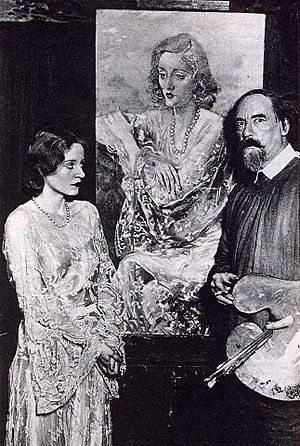
While John was known for his drawings and etchings early in his career, most of his later work was portraits. His paintings of his two wives and his children are considered some of his best. He was known for capturing the true personality of the people he painted. Some people even found his portraits "cruel" because they showed the truth so clearly. For example, Lord Leverhulme was so unhappy with his portrait that he cut off the head!
By the 1920s, John was the most important portrait painter in Britain. He painted many famous people of his time, including T. E. Lawrence, Thomas Hardy, W. B. Yeats, Aleister Crowley, Tallulah Bankhead, George Bernard Shaw, and the cellist Guilhermina Suggia. Perhaps his most famous portrait is of his fellow Welshman, the poet Dylan Thomas. John actually introduced Dylan Thomas to Caitlin Macnamara, who later became Thomas's wife. You can see portraits of Dylan Thomas by John at the National Museum Wales and the National Portrait Gallery.
Some critics say that after the war, his painting style became less detailed. However, his artistic spark would return sometimes, like during a trip to Jamaica in 1937. The paintings he made in Jamaica showed a new burst of his creative energy. In 1944, Sir Bernard Montgomery asked John to paint his portrait, but he didn't like the finished work.
His Family Life
In 1901, John married Ida Nettleship, who was also an artist and had studied with him at the Slade School. They had five sons. After Ida passed away in 1907, Dorothy "Dorelia" McNeill lived with John for the rest of their lives. They had four children together, even though they never married. One of his sons with Ida, Casper, became a very important British Admiral. His daughter with Dorelia, Vivien John, also became a notable painter.
His son Romilly (born 1906) was a poet, author, and amateur physicist. His daughter Poppet (born 1912) married a Dutch painter.
Later Years and Legacy
In his later years, John wrote two books about his life: Chiaroscuro (1952) and Finishing Touches (1964). Even though he wasn't as central to British art in his old age, people still respected him greatly. A huge exhibition of his work was held by the Royal Academy in 1954. He continued to paint until he passed away in Fordingbridge, Hampshire, in 1961, at the age of 83. His very last painting was a large mural.
In the 1950s, he joined the Peace Pledge Union, a group that believes in peace and avoiding war. He was also a founder of the Committee of 100, which protested against nuclear weapons. On September 17, 1961, just before he died, he joined an anti-nuclear weapons protest in Trafalgar Square, London. At that time, his son, Admiral Sir Caspar John, was a very high-ranking officer in the navy.
Augustus John is thought to be the inspiration for the artist character in Joyce Cary's novel The Horse's Mouth. This book was later made into a film in 1958 starring Alec Guinness.
Many exhibitions have shown his work, including a major one called 'Gwen John and Augustus John' at Tate Britain in 2004/5. This exhibition showed how different, yet connected, his art was to his sister Gwen's.
Honors and Recognition
Early in his career, John became a leading artist in the New English Art Club. With his lively way of painting portraits and his skill at capturing unique parts of his subjects, he became England's most fashionable portrait painter, even more popular than John Singer Sargent. In 1921, he was chosen to be an Associate of the Royal Academy, and then a full member in 1928. King George VI gave him the Order of Merit in 1942, which is a very special honor. He also served as a trustee of the Tate Gallery and President of the Royal Society of Portrait Painters. On October 30, 1959, he was given the Freedom of the Town of Tenby, his birthplace. When he died in 1961, The New York Times said he was seen as "the grand old man of British painting, and as one of the greatest in British history."
Where to See His Work
His paintings and drawings are kept in many museums around the world. Some of these include the Museum of New Zealand, the Santa Barbara Museum of Art, the British Museum, the Museum of Modern Art, the Brooklyn Museum, the National Museum Wales, and the Philadelphia Museum of Art.
Gallery
See Also
 In Spanish: Augustus Edwin John para niños
In Spanish: Augustus Edwin John para niños
- Vernon Watkins
- Marchesa Casati – Augustus John painting of Luisa Casati


